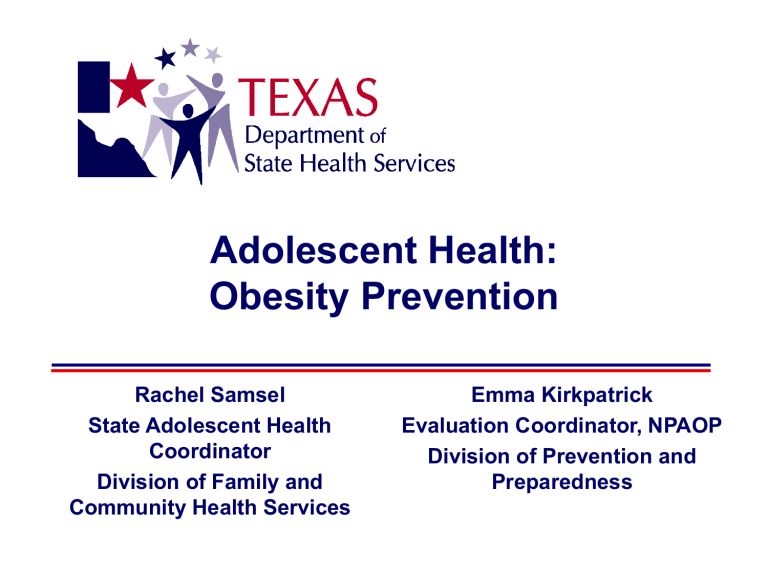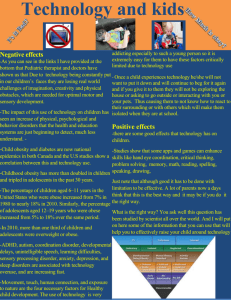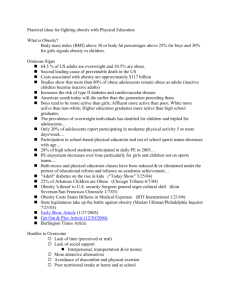Adolescent Health Briefing – Obesity Prevention ..................... Rachel

Adolescent Health:
Obesity Prevention
Rachel Samsel
State Adolescent Health
Coordinator
Division of Family and
Community Health Services
Emma Kirkpatrick
Evaluation Coordinator, NPAOP
Division of Prevention and
Preparedness
Acknowledgements
• Division of Family and Community Health
Services
Office of Program Decision Support
• Division of Prevention and Preparedness
Nutrition, Physical Activity, and Obesity
Prevention
Child Health and Safety Branch
Page 2
Outline
• Data
• Prevalence of Adolescent Obesity
• Adolescent Nutrition and Physical Activity Behaviors
• Costs and Impact of Adolescent Obesity
• Programmatic Response
• Get Fit Kit
• School Physical Activity and Nutrition (SPAN) Survey
• Texas School Health Advisory Council
• State Obesity Prevention Strategic Plan
• Policy and Environmental Change Efforts
• Other related efforts
Page 3
Prevalence of Adolescent Obesity and Related Behaviors
Page 4
Prevalence of Adolescent
Obesity
• 15.6 % of students are overweight
• (i.e., at or above the 85th percentile but below the
95 th percentile for body mass index, by age and sex)
• 13.6% of students are obese
• (i.e., at or above the 95th percentile for body mass index, by age and sex)
• This is a decrease from 15.9% in 2007
Youth Behavior Risk Survey, 2009
Page 5
Prevalence of Adolescent
Obesity
• National data from 2003–2004 show high childhood obesity prevalence among African
American girls (24%) and Hispanic boys (22%).
• In Texas, nearly 20% of African American 11 th grade males are extremely obese.(99 th percentile)
• More than one-third (35%)of Hispanic 4th grade boys were obese and almost two times more likely than their White peers to be obese.
Youth Behavior Risk Survey, 2009
SPAN III, 2004-2005
Page 6
Adolescent Nutrition and Physical
Activity Behaviors Related to
Obesity
% of youth reporting nutrition behaviors
80.00%
79.00%
78.00%
77.00%
76.00%
75.00%
78.70%
77.70%
Ate fruits and vegetables less than five times per day
Texas
US
20.00%
15.00%
10.00%
5.00%
0.00%
14.30%
11.40%
Did not eat fruit
Texas
US
Youth Behavior Risk Survey, 2009
Page 7
Adolescent Nutrition and Physical
Activity Behaviors Related to
Obesity
% of youth reporting physical activity and screen time
65.00%
60.00%
55.00%
50.00%
53.40%
63.00%
45.00%
40.00%
Physically active at least 60 minutes per day on less than 5 days
Texas
US
45.00%
40.00%
35.00%
30.00%
36.30%
32.80%
25.00%
Watched television 3 or more hours per day
Texas
US
Youth Behavior Risk Survey, 2009
Page 8
FITNESSGRAM Results
Page 9
Costs and Impacts of
Adolescent Obesity
• Over the next 15 years, Texas’ adult obesity rate could rise to 48.6%
• Annual average health care cost per worker up by nearly 500%, to almost
$1,300
Source: Texas Comptroller of Public Accounts and
U.S. Centers for Disease Control and Prevention
Page 10
Costs and Impacts of
Adolescent Obesity
Source: Texas Comptroller of Public Accounts and
U.S. Centers for Disease Control and Prevention
Page 11
Adolescent Obesity and Associated
Issues
• The longer a child is overweight, the more he or she is at risk for depression and other mental health disorders.
• In an 8 years study, chronically obese boys were four times more likely to suffer from depression than their non-obese male peers
• Another study (JAMA) found that obese kids were 5.5 times more likely to have an impaired quality of life than healthy kids, comparing their quality of life with that of kids undergoing chemotherapy treatment for cancer.
• Both sexes were two and a half times more likely to suffer from oppositional defiant disorder.
Page 12
Adolescent Obesity and Associated
Issues
• Obese and overweight adolescent girls were more likely to have sex before the age of 13 years
• Overweight and obese females were 30% more likely to report more than 3 lifetime sexual partners before graduating from high school
• 20% less likely to use condoms than their normalweight peers
• Overweight girls were 30% less likely and obese girls were 40% less likely to report any form of contraception at last intercourse than normal-weight adolescent girls
*Youth Behavior Risk Survey, United States, 2007
Page 13
Adolescent Obesity and Associated
Issues
• Obese boys and girls were more than 2 times more likely than normal-weight youngsters to be victims of "relational" bullying
• Obese girls were about twice as likely to be physically bullied on a weekly basis than normal-weight girls
• Obese girls were more than five times more likely than normal-weight girls to physically bully other youngsters at least once weekly.
Page 14
Adolescent Obesity and Associated
Issues
• Increased diagnosis of Type 2 diabetes and hypertension in adolescents
• Higher lifetime risk for a host of serious health problems, such as heart disease, stroke, diabetes, asthma, and some forms of cancer
• The stigma of obesity carries psychological and social consequences
• The chance of an obese teen becoming an obese adult is as high as 80%
Page 15
Factors Attributed to Obesity
• Other conditions or psychosocial factors attributed to obesity:
• Depression
• History of abuse or domestic violence
• Underlying medical conditions (polycystic ovarian syndrome; Prader-Willi Syndrome)
• Environmental (home, school, community)
• Behavioral (energy intake, physical activity, sedentary behaviors)
Page 16
Review of the Data Presented:
Take Home Messages
• Approximately 1/3 of adolescents in Texas are overweight or obese
• Obesity is not solely a physical condition
• Obesity is directly associated with other high risk behaviors
• Obesity prevention requires a multi-pronged approach to be effective
Page 17
Programmatic Response
Page 18
Get Fit Kit
• The follow-up to FITNESSGRAM and AN Screening
• Informative tool to improve health of students identified by the FITNESSGRAM and AN
Screenings as overweight or obese
• Lessons included in the Get Fit Kit:
• Healthy eating habits
• Physical fitness
• Living with Diabetes
• Goal: Awareness and Behavior Change
Page 19
School Physical Activity and
Nutrition Survey (SPAN)
• Partnership with UT School of Public Health Dell Center for the Advancement of Healthy Living
• Identifies factors that may underlie obesity
• dietary behaviors,
• nutrition knowledge and attitudes, and
• physical activity
• Survey 4 th , 8 th and 11 th graders in 100 school districts
• 2009-2010 survey included a matched 4 th grade parent survey
• Added questions related to bullying, body image, depression, and other psychosocial issues that impact health behaviors
Page 20
Texas School Health Advisory
Committee
• Accomplishments:
• Developed resource tool that provides information on physical activity and academic success
• Developed position statement on the importance of recess and physical activity during the school day
• Made recommendations for offering physical activity outside school day
• Developed FITNESSGRAM Guide for use by parents
• Made recommendations for modifications to coordinated school health program requirements as requested by law
Page 21
Nutrition and Physical
Activity Strategies
• Consumption of fruit and vegetables
• Physical Activity
• Breastfeeding
• Consumption of sugarsweetened beverages
• Consumption of highenergy-dense foods
• Television viewing
Page 22
Combined Obesity RFP
• Nutrition, Physical Activity & Obesity Prevention Program,
Office of Title V and Family Health, and the Office of Border
Health
• Evidence-based Physical Activity and Nutrition projects inline with the CDC “Measures”
• Total amount: $2,565,376 (awards ranging $150,000 to
$300,000 per project)
• 11 communities were awarded funds
• Five projects included strategies for children and adolescents totaling $900,000
Page 23
Combined Obesity RFP
• Teaching and Mentoring
• Regions 1, 8, 11
• Physical activity curriculum in early childhood settings and at home
• Texas A&M University System Health Science
Center Research Foundation
• Region 11
• Pilot project of Edinburg ISD and Cameron, Hidalgo, and Starr
Counties
• Brazos Valley Community Action Agency
• Region 7
• Train youth to conduct assessments, utilize photovoice, and share findings to educate local public officials
Page 24
Combined Obesity RFP
• Community Council of Greater Dallas
• Region 2/3
• Plan to improve infrastructure to increase walkability in target neighborhood.
• Texas State University - San Marcos
• Region 8
• Partner with restaurants for increased availability of fruits/vegetables; develop kid-friendly portion appropriate plate as learning tool
• Work with restaurants to offer kids menu items on the plate
Page 25
Strategic Plan for the Prevention of Obesity in Texas
NPAOP Partner Meeting and Summit - July 2009
Subject Matter Experts
• Physical Activity
• Community Design Physical
Activity
• Nutrition
• Community Design Nutrition
• Breastfeeding
Total of 30 persons interviewed
Preliminary Data Collection
Community Representatives
Small Communities (3)
Medium —Sized Communities (3)
Large Communities (4)
Total of 33 persons interviewed
Conference Surveying
Texas Pediatric Society
Texas Trails Conference
Houston Obesity Summit
Input from a total of 64 persons
Approximately 127 Partners provided preliminary input
Survey of Partners
Completion Rate: 54.08% (272)*
*Varies by question in total 503 people gave input (82.7%)
Page 26
DRAFT
Mission, Vision, and Goals
Goal:
To improve the health of all Texans through improved nutrition and increased physical activity
Vision:
Where active living and healthy eating is the Texas way of life
Mission:
To provide Texas communities with tools to create environments to support healthy eating and active living
Page 27
PlanHealthyTexas.org
Coming Soon
Communities Putting Prevention to
Work – States and Territories Initiative
Component I
• $2.2 million
• $1.1 Million for Tobacco Prevention & $1.1 for Obesity Prevention
• Schools as central community access points
• Fresh produce
• Recreation facilities
• Online Community Action Tool
• www.PlanHealthyTexas.org
Component II
• $2.7 million
• Optimal breastfeeding support in worksites mainly facilitated through state agencies
• Mother Friendly Work Place
• Organizational policy change
Page 29
Environmental Factors
Impacting Adolescent Obesity
Page 30
Page 31
Page 32
Page 33
Page 34
Louisiana Complete Streets Policy
Page 35
California Joint Use Agreements
Page 36
Various States: Farm to School
Page 37
Take Home Message
Policy and environmental change initiatives that make healthy choices in nutrition and physical activity
Available , Affordable ,
& Easy
Will likely prove most effective in combating obesity.
Page 38






